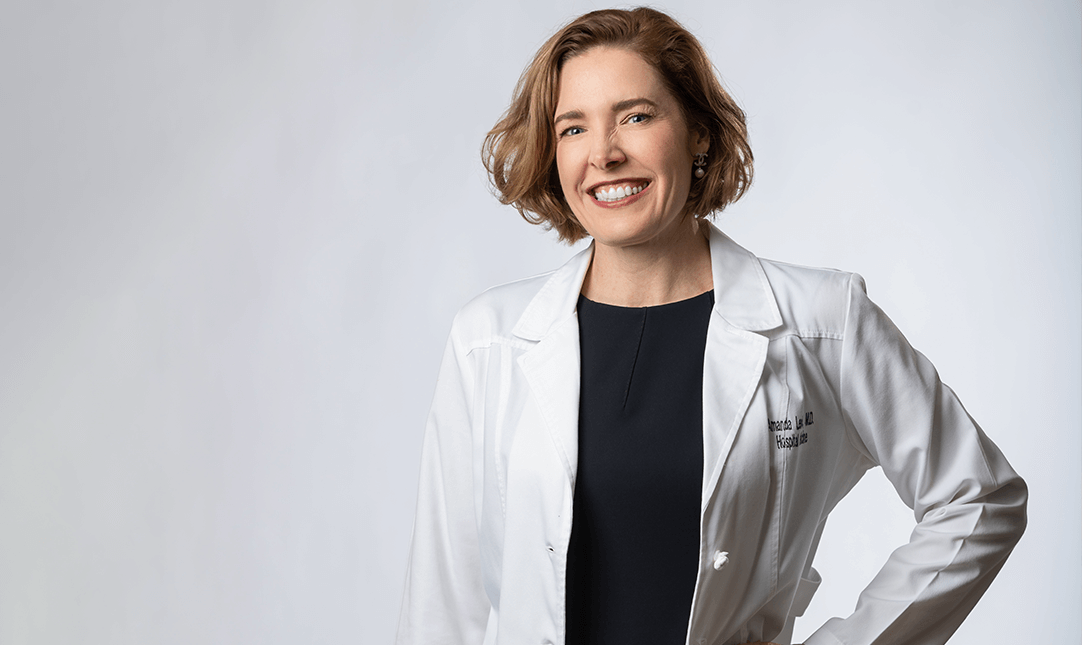“People talking to people can solve problems together”
When patients are ready and able to leave the hospital, how to get them safely and efficiently to their homes or to other care facilities is a hugely complex challenge. It involves the coordinated work of physicians, nurses, laboratory and imaging technicians, transporters, pharmacists, environmental services associates, physical and occupational therapists, health unit coordinators, executives, pathologists, social workers, and more.
Amanda Lenhard understands this complexity better than many because she is a hospitalist, a physician who specializes in the care of people in the hospital.
“So many people care for our patients as they go through Shadyside,” Dr. Lenhard explains. “Every person who touches a patient has a potential opportunity to help that patient move through our hospital, get answers in a timelier way, be ready to leave the hospital at the right time, and help other people who may be waiting for treatment.
“And what I have learned about Shadyside Hospital is that the people who work here are true professionals who really care about helping patients — and they want to help each other care for them in world-class ways.
“So I thought, ‘We need to bring everyone together. People talking to people can solve problems. If we would just have a daily 30-minute meeting — like a remote SWAT team — with frontline providers and leaders on the call, we could share our knowledge and expertise. We could teach each other where the obstacles are and how to remove them. Speaking to each other daily on SWAT can help us identify trends, share results, create new ways to be more efficient, and help each other do our best work.’
“So this SWAT team came out of a place of humble understanding that you’re not the only person caring for this patient,” Dr. Lenhard says. “We wanted our people to know you’ve got a team ready to support you. There are so many people who are trying to help you and get the patient home. We just need to share what we know about the barriers and then prioritize the solutions. Because, often, you don’t know what you don’t know.”
To help her learn, Dr. Lenhard turned first to Lisa Donahue, DNP, RN, CPPS, senior director of Patient Safety, Innovation & Quality, and Sherri Jones, MS, MBA, RDN, LDN, SSGB, CPHQ, FAND, then a senior innovation improvement specialist and now quality manager. “They were my partners from the very beginning,” she says. “They knew how to bring people to the table.”
“Dr. Lenhard is the first to have pulled in every level of employee and service onto the team,” states Kitty Zell. “Getting their input has really made it a different team than we’ve ever had before. It has been eye-opening for people to get out of their silos and understand the needs of all the disciplines who are focused on each patient.”
“It’s nice to see the team working together instead of everybody working in their little silos,” agrees Cynthia Conte, MSN, RN, director of Patient Care Services. “Everybody’s working for the well-being of the patient. And the key to all of it is communication. A lot of education and collaboration have been done through this team. It is a space for camaraderie and teamwork to build.”
“Dr. Lenhard and these SWAT meetings are truly teaching us the difference we can make in getting these patients home when they should be,” says Darla Lower, who manages the automated testing laboratory that processes about 2.5 million tests a year. Ms. Lower, whose career began when she worked on an anti-rejection drug program with Dr. Thomas Starzl, the pioneering transplant surgeon, in the 1980s, adds that “this has been eye opening. I think it’s bringing everybody’s awareness to a greater level, and that can only be a good thing.”
Tina Fullum, the health unit coordinator responsible for making the Family Medicine Unit run smoothly for 29 of the 30 years she has worked at Shadyside, says she felt “very honored that Dr. Lenhard asked me to be on the SWAT team. I get on the calls even when I’m on the bus on my way home (I’m here at work before 6 a.m.) — and I love it. If I can contribute some information they need, it makes me feel important. And I’ve learned something new every day about the way things work behind the scenes in the hospital. I think that helps me be more helpful to my co-workers. It makes me look smart,” Ms. Fullum says with a grin.
“Dr. Lenhard has done an amazing job with the program,” says Alanna Peterson, MD, section chief of Emergency Medicine. “The team works diligently each afternoon to identify which patients can be safely discharged that day. A valuable part of that effort is that the team is multi-disciplinary so any additional testing required for discharge can be coordinated in real time.”


